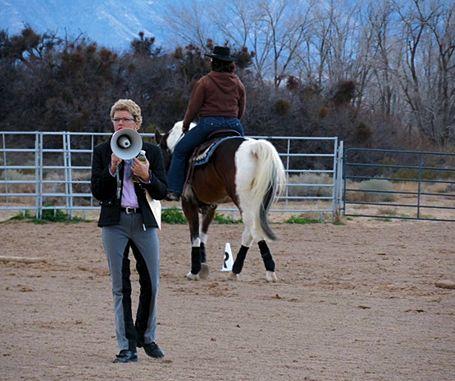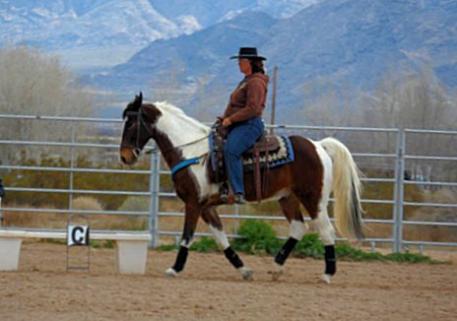Western Dressage: Classical Horsemanship for Today's Rider
Sunday, March 8, 2015 | Mary Phelps


On an overcast winter day a group of horses and riders gather in Sandy Valley. The scene is reminiscent of the Old West—the horses wear hefty leather saddles and their riders wear blue jeans and cowboy boots. But this is no rodeo. The Sandy Valley group is participating in a Western Dressage 1-2-3 clinic endorsed by the North American Western Dressage organization. Today’s clinic will include plenty of riding and end with a videotaping session: a “virtual” show.
Western Dressage is based on the principles of classical horsemanship. Remember those dancing white Lipizzaner stallions? Why would today’s cowboys be interested in dancing horses? Western Dressage techniques improve the horse and rider’s performance by teaching the horse to collect, or bring his hindquarters underneath him, in preparation for a change in direction or speed. The horse becomes more responsive to the rider’s signals, or aids, such as yielding to leg pressure or shifts in the rider’s weight. Riders benefit, too, by learning to clearly communicate their wishes.
Callie Klein of Cloud Nine Ranch LLC is presenting today’s clinic at Sandy Valley’s BJC Arena. Klein is a recognized professional with the North American Western Dressage Association and developed the curriculum for the Western Dressage 1-2-3 clinics. Klein is also a graduate of the Western Dressage Association of America’s Train The Trainer™ program and her extensive background in Natural Horsemanship informs the way she instructs. “I teach about the natural ways that horses communicate among one other, how horses understand humans, and how you can develop communication and create harmony with your horse—on and off the saddle.”

Sharon Fiato is attending the clinic riding her colorful gaited horse, Chip. Fiato’s goal is to improve her partnership with Chip while developing Chip’s flexibility, balance, and overall athleticism. Western Dressage techniques work to improve performance with all horses regardless of breed, size, ability, or previous training.
The Western Dressage 1-2-3 clinics are uniquely organized. After only a few hours of instruction, the horse and rider learn several patterns. These patterns are known as “tests” and have increasing levels of difficulty. Each pattern includes changes in direction and transitions in the horse’s speed. Locations in the arena are marked and cue the rider where to perform each part of the test. Then the pair is videotaped performing their chosen pattern. The videotape is sent to a judge who is certified with the North American Western Dressage association. Within a week, the judge finalizes a score sheet for each horse and rider’s performance and assigns a number, or grade, for that test. The rider can use the grade and judge’s feedback to work towards improving performance. All results are kept confidential unless the rider chooses to compete for a North American Western Dressage achievement award.
Klein enjoys teaching students Western Dressage principles and techniques. “My clinics are really fun and a valuable platform for learning. Our virtual shows are an awesome low-key opportunity to get a certified judge’s feedback without the pressure or high cost of attending a show.” The relaxed atmosphere helps riders increase their confidence, try something new, and most of all have fun with their horses. Each three hour clinic includes group instruction, work both off and on the horse, and the virtual test video session with a certified Western Dressage judge’s score and comments. For more information call 702-326-9440, email info@callieklein.com, or visit callieklein.com.















